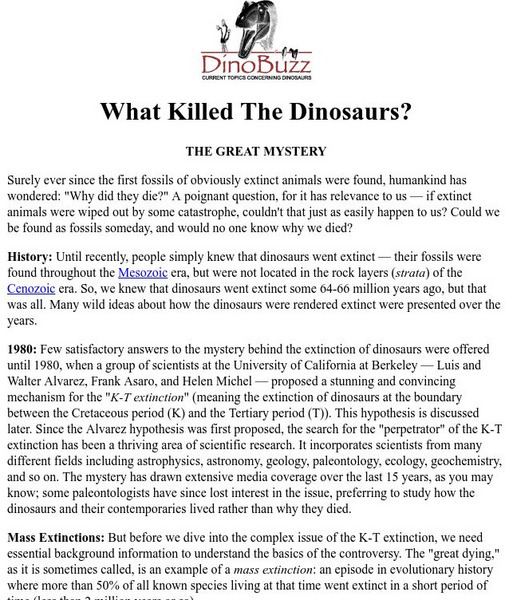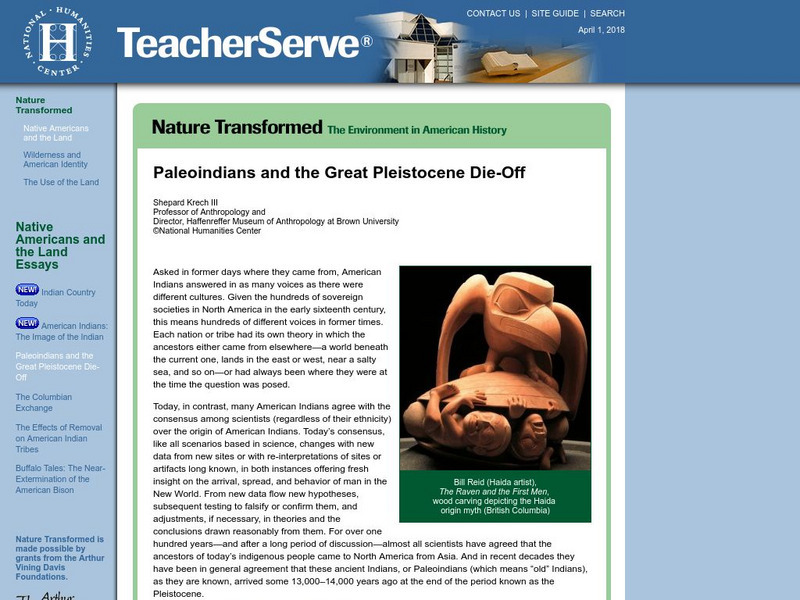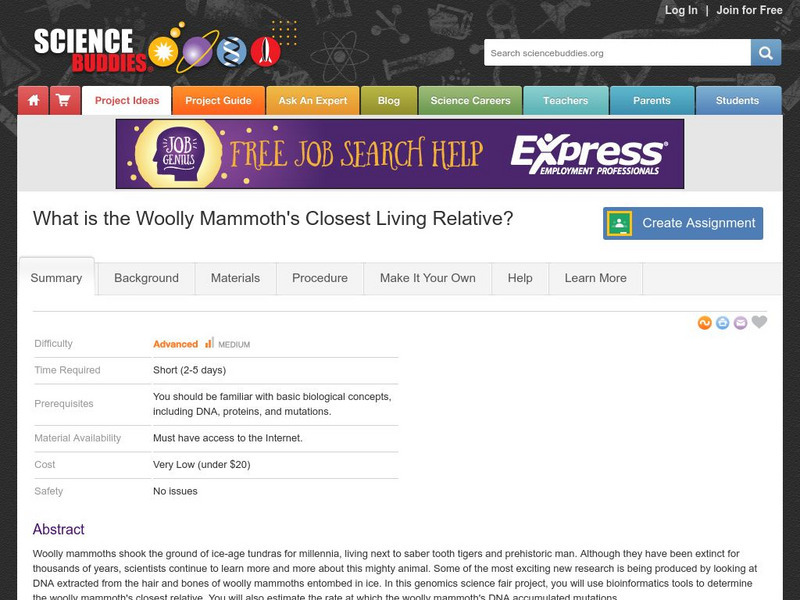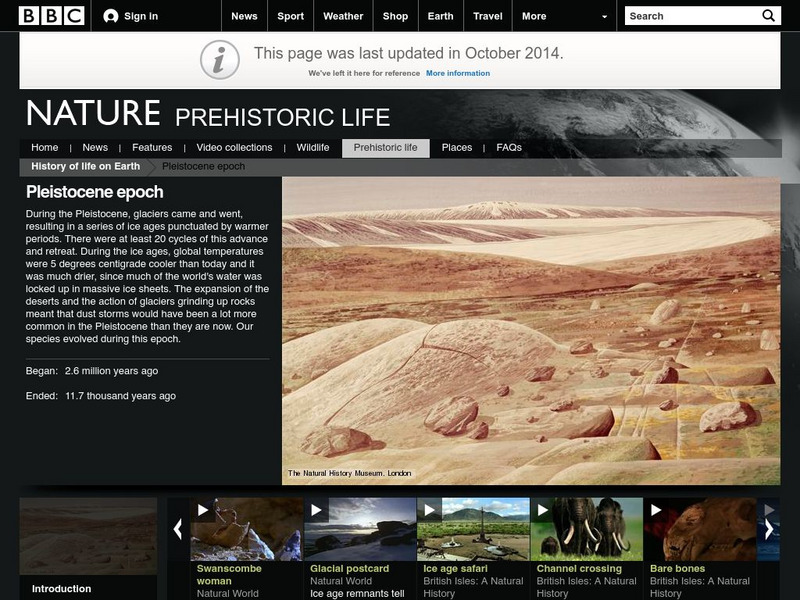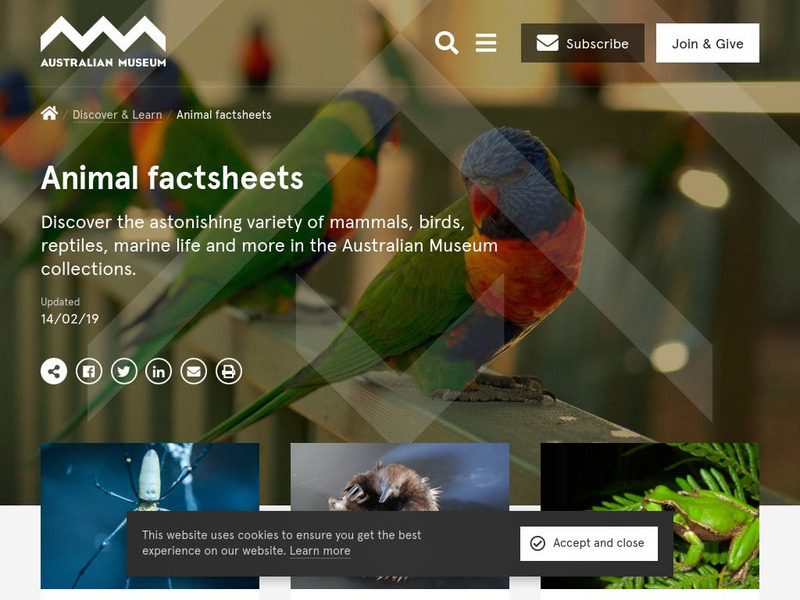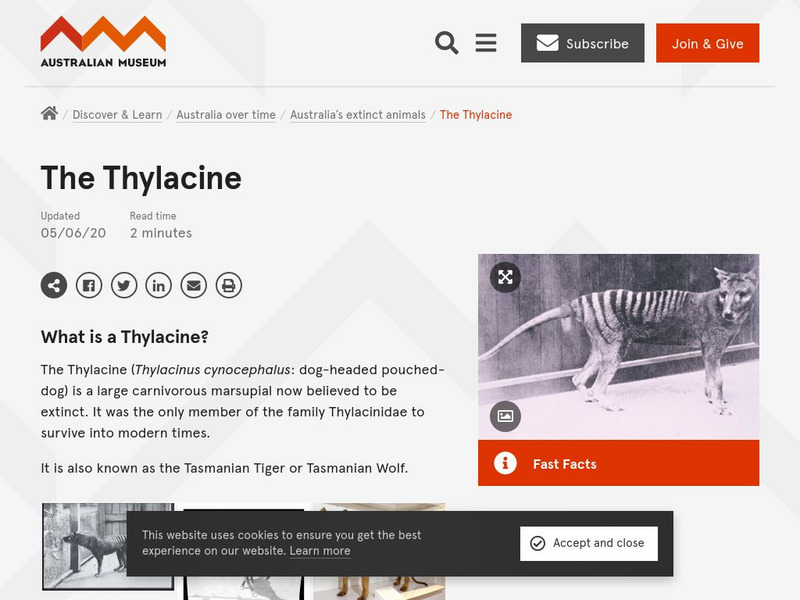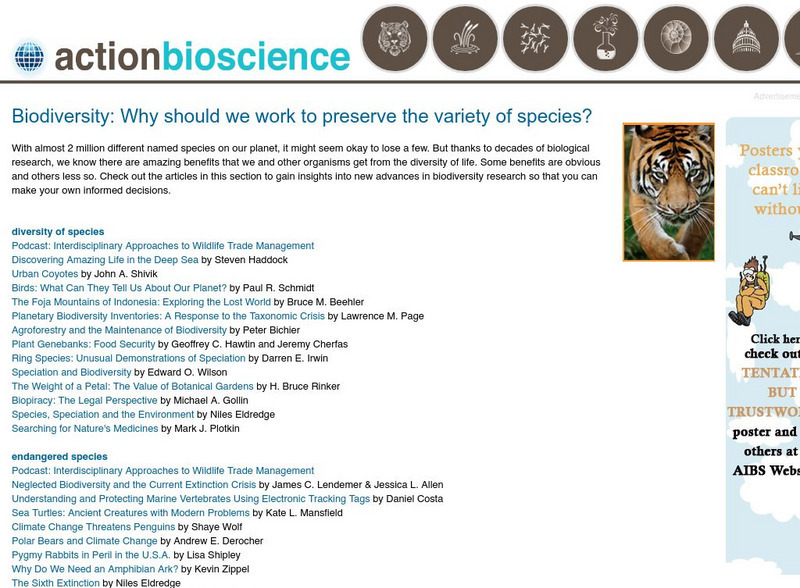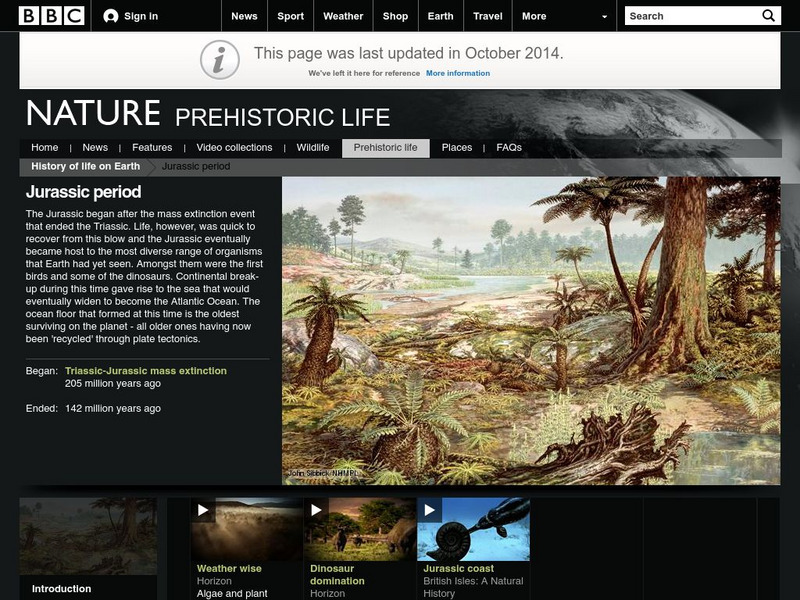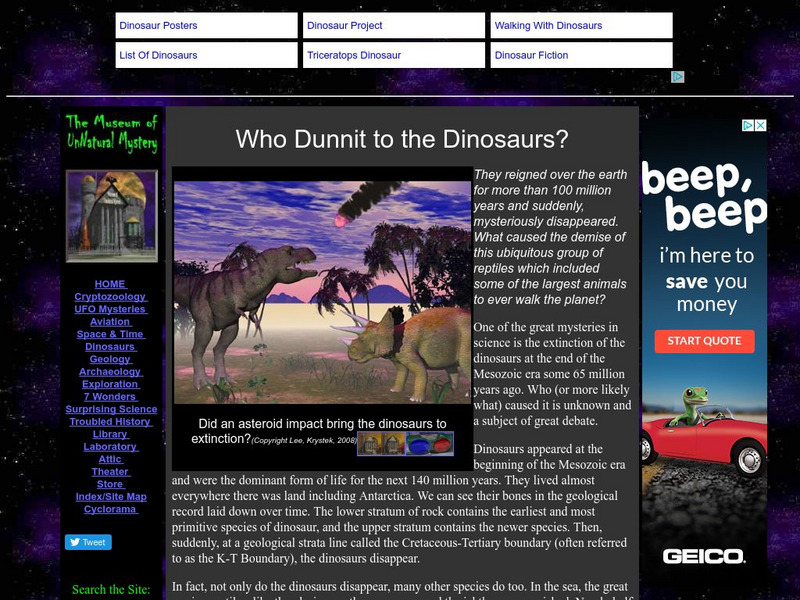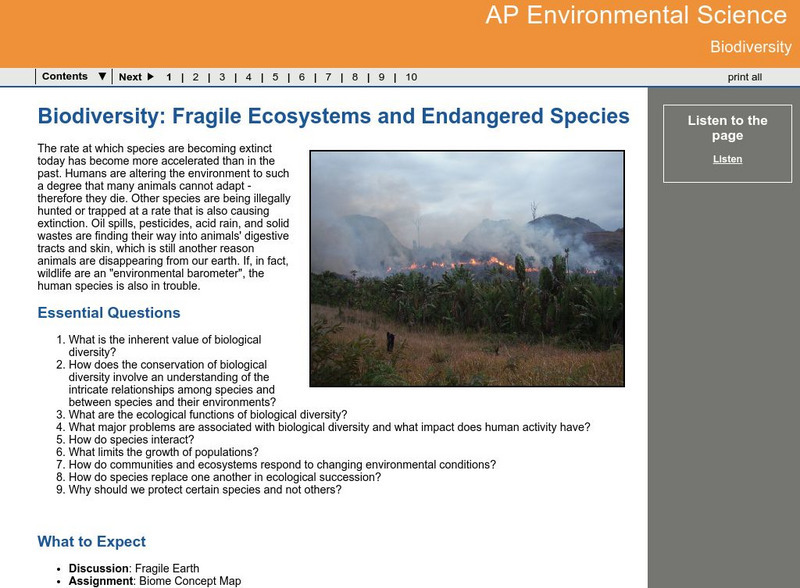Hi, what do you want to do?
Other
Scientists Say Star Collision Caused Dinosaur Extinction
"Israeli scientists have a new theory on why the dinosaurs became extinct: cosmic radiation that bombarded the Earth following the collision of two neutron stars." This article discusses the details of the theory.
University of California
Ucmp: What Killed the Dinosaurs?
This UC Berkeley site extensively covers the death of the dinosaurs. It includes history, theories, invalid hypotheses, and current arguments.
National Humanities Center
National Humanities Center: Teacher Serve: Paleoindians and the Great Pleistocene Die Off
Article discusses Paleoindian migration and animal extinction at the end of the Pleistocene era and explores what we can learn about conservation given what we know about Pleistocene climate and extinction.
Other
Black Hills Institute of Geological Research, Inc.: Ammonoids
Ammonoids, more commonly referred to as Ammonites, are the extinct ancestors of today's octopus, squid and nautilus. This page provides excellent information about these creatures, as well as diagrams and pictures.
Concord Consortium
Concord Consortium: Stem Resources: Changes in the Environment
An activity to help students understand that as the environment changes, plants and animals must evolve to stay alive. Students watch as a mystery plants grow in a changing environment to see if they will evolve or go extinct.
Science Buddies
Science Buddies: What Is the Woolly Mammoth's Closest Living Relative?
Although Woolly Mammoths have been extinct for thousands of years, scientists continue to learn more and more about this mighty animal. Some of the most exciting new research is being produced by looking at DNA extracted from the hair...
Other
The Nature Conservancy of Hawaii: A Guide to the Order of Trilobites
The trilobite of the months greets you on this award winning site that provides an immense data base of facts on this fascinating but extinct arthropod. Start with the Introduction in the left hand menu bar for easy to understand...
CK-12 Foundation
Ck 12: Episd: Life During the Paleozoic
[Free Registration/Login may be required to access all resource tools.] From the beginning with the Cambrian explosion and ending with the Permian extinction students will go in depth studying the Paleozoic Era that occurred hundreds of...
BBC
Bbc Nature: Prehistoric Life: Pleistocene Epoch
Overview of the Earth in the Pleistocene Epoch told by photos, news, and external links with an emphasis on what grew then, what lived then, the causes of mass extinction, types of fossils, and what life was like in general.
BBC
Bbc Nature: Prehistoric Life: Cretaceous Period
Overview of the Earth in the Cretaceous Period told by photos, news, and external links with an emphasis on what grew and lived then, the causes of mass extinction, types of fossils, and what life was like in general.
Australian Museum
Australian Museum: Animals
This online site for the Australian Museum introduces the nature and culture of this unique continent. This particular section focuses on the creatures of Australia including spiders, fish, birds, reptiles, mammals, insects, frogs,...
Better Lesson
Better Lesson: Birds Help Their Young Survive (Bald Eagles)
Birds protect their young in some cool ways! See how our national bird cares for its chicks. Students will read a National Geographic article about Eagles becoming extinct, and will watch a video on Iowa Bald Eagle cameras. Students will...
Australian Museum
Australia Museum: Thylacine
The Thylacine, once an inhabitant of Australia is now extinct because of excessive hunting and competition with dingos and dogs. The Australian Museum provides general information on this interesting carnivore and photographs of the last...
PBS
Pbs Learning Media: Mammals Get Their Chance
In this video segment adapted from NOVA, animations of an asteroid hitting Earth are used to illustrate this widely accepted theory of dinosaur extinction and the resulting conditions that favored mammals.
American Institute of Biological Sciences
Action Bioscience: Biodiversity
This site from the American Institute of Biological Sciences contains articles on a wide array of issues related to species diversity and extinction. Many articles available in Spanish.
Other
Dinosaurios: Dinosaurs
In-depth presentation about the world of dinosaurs. Includes pictures and diagrams. Information about types, characteristics, and extinction.
Cornell Lab of Ornithology
Cornell Lab of Ornithology: Modern Extinctions on Mainland North America
Since 1850 North America has lost three bird species--the Labrador Duck, Passenger Pigeon, and Carolina Parakeet--and the continued existence of another three is unlikely, namely the Eskimo Curlew, Ivory-billed Woodpecker, and Bachman's...
DOGO Media
Dogo News: The Real Life King Kong
Article reports on the circumstances that may have led to the extinction of real-life giant apes. Includes video.
TeachEngineering
Teach Engineering: News Flash!
This activity illustrates the interrelationship between science and engineering in the context of extinction prevention. There are two parts to the activity. The first part challenges students to think like scientists as they generate...
BBC
Bbc Nature: Prehistoric Life: Jurassic Period
Overview of the Earth in the Jurassic Period told by photos, news, videos, and external links with emphasis on what grew then, what lived then, the causes of mass extinction, types of fossils, and what life was like in general.
Other
Who Dunnit to the Dinosaurs?
"One of the great mysteries in science is the extinction of the dinosaurs at the end of the Mesozoic Era some 65 million years ago. Who (or more likely what) caused it is unknown and a subject of great debate." Many theories are touched...
PBS
Pbs Learning Media: Fossils in the Gobi
Biologist Mike Novacek discusses his discovery of mammal fossils in the Gobi Desert and tells us what we can learn from them. From an episode about extinction broadcast on the PBS series "Evolution."
Curated OER
Extinctions: Cycles of Life and Death Through Time
Visit this website to read about the extinctions that have occured throughout Earth's history. Provided are links to very brief summaries of the extinctions (minor and major) that occured during specific periods of time.
Georgia Department of Education
Ga Virtual Learning: Ap Environmental Science: Biodiversity
Through an interactive learning module, students investigate the importance of species richness and biological diversity.
Other popular searches
- Dinosaurs and Extinction
- Dinosaur Extinction
- Animal and Plant Extinction
- 4th Grade Extinction
- Species Extinction
- Bird Extinction
- Mammoth Extinction
- Extinction of Organisms
- Fish Extinction
- Extinction Environment
- Dinosaur Extinction Theories
- Mass Extinction Time Line






